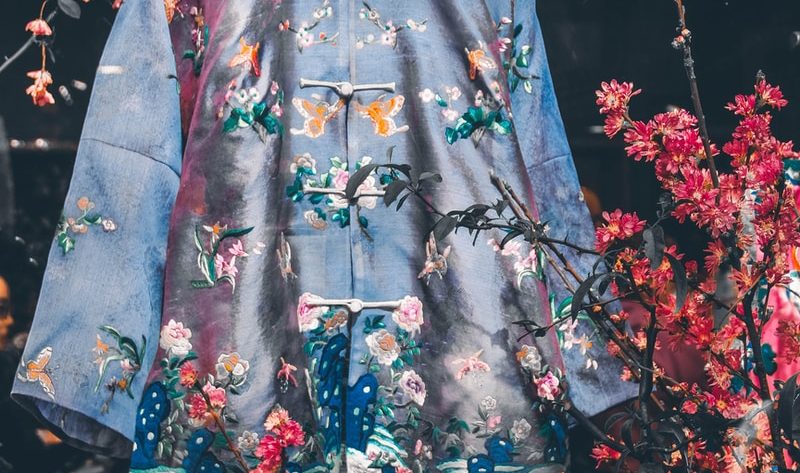Cultural appropriation: Although the term is becoming more popular in recent years, cultural appropriation has been practiced for a long time. Kunstmuseum Den Haag focuses on this phenomenon in its new exhibition “Global Wardrobe – The Worldwide Fashion Connection”, but it is also frequently discussed in talks about diversity in fashion. Experts ask: What is this? Where is the line between appreciation and appropriation? How can we prevent it?
First, let’s define cultural appropriation. In the press release about the exhibition, the Kunstmuseum Den Haag describes it as “copying” from other cultures. Sometimes without proper reference to the source. Janice Deul, a writer, curator, and activist, described the phenomenon in a talk at Digital Fashion Week Europe last summer. She said that symbols are often copied from other cultures without any consideration of their meaning. This often involves elements from marginalized cultures.
Fashion houses and brands have come under fire for using symbols, printed and garments from other cultures in recent years. This is evident in recent cases like Isabel Marant’s and Louis Vuitton’s. Mexico indicted Isabel Marant, a fashion designer from Mexico, for commercially exploiting traditional Mexican designs in a line. In 2015, the designer was also accused of similar offenses. Marant later apologized for culturally appropriating the patterns. Marant admitted that Purepecha patterns were indeed used as inspiration. She said that she would honor the source of her inspiration in the future.
After criticisms on social media, Louis Vuitton drew a scarf that was inspired by the Palestinian Keffiyeh. The Palestinian keffiyeh has been regarded as a symbol for nationalist Palestinianism. The original black-and-white pattern of the Keffiyeh scarf was replaced by a blue version. Additionally, the brand added its monogram to the scarf. The price tag? $705. The timing of the item was also very unfortunate as there were several bombings in Palestine at that time.
But, there are many more examples. For example, Karl Lagerfeld used a Koran verse as a print on his Chanel summer collection corset in 1994. Lagerfeld apologized for the error and said that he believed the verse was an Indian love song inspired by the Taj Mahal. Chanel promised to burn the three dresses that had verses on them.
The Kunstmuseum’s new exhibition can be viewed from 9 October through 16 January 2022. It shows how for a long period it was common to use traditional costumes, clothing, and symbols from other cultures in the name of ‘appreciation, inspiration,’. The ‘Japanese Rock’ is a dressing gown that was worn by wealthy men in 17th-century Japan. It was considered a status symbol. The turban and the Kashmir scarf are also popular. Sometimes clothing worn in India or China by men was also put on by women in Europe. Many women in Western Europe wore an evening coat made from a Chinese men’s coat, which served as a cover for their evenings. According to the Kunstmuseum, it was valued for its handicrafts, decorations, and the beauty of Chinese embroidery. However, almost all of them did not understand the symbolism of Chinese embroidery. Cultural appropriation was also a big part of the 1970s, with hippies wearing Afghan clothing. Cultural appropriation in fashion is much older than we think. It just wasn’t called that.
How can we stop cultural appropriation? It can only be prevented by cooperation
In one instance, Alejandra Frausto, Mexico’s Minister of Culture, writes a letter to a company. Another chooses to sell licenses for their names or well-known patterns, and claim licensing income from fashion houses. For example, take the Maasai, an African tribe living in Kenya and Tanzania. Kim Jones, a Kenyan-born child, used Maasai prints in his Louis Vuitton debut in 2011. This is not the first time that prints or names of Maasai have been used in fashion.
Nine elders from the tribe formed an organization called Maasai IP Initiative Trust Ltd. (MIPI) two years prior to Jones’s debut at Louis Vuitton. MIPI is a professional organization that takes the cultural heritage of Maasai into their own hands. It offers a clear process for commercial users to apply for licenses. The Maasai community will benefit from the proceeds of licenses. They can use the money to support their health, education, and to repurchase the rights to water and land to graze livestock. We reached out to MIPI to inquire about the success rate of the organization, but has not received a response.
Let’s take it one step further. Is it possible for a community to sue for cultural appropriation? We called Nine Bennink, Koster Advocaten in Haarlem. Bennink responds that there is a procedural choice when it comes cultural appropriation. This is because copyright can be reverted back to. The lawyer stated that although most communities have not registered trademarks, copyright exists from the moment an item is created. This lawsuit is not desirable for fashion houses. “The cost of losing face is much greater than paying compensation to the community or paying licensing fees.” The cost of a license is not set in stone, since there is no standard. Bennink knows that fashion houses are becoming more cautious about cultural heritage. This is partly due to the reputational damage it can cause and the fact that communities may win in court. Bennink views copyright primarily as a tool that can be used to help address social problems. “But the social pressures and possible loss of face that a fashion house may suffer are in reality also powerful tools.”
“Equal collaboration is necessary to stop cultural appropriation of fashion”
Is there a way to stop cultural appropriation? There are many other sides to this. It is important to remember that the heritage of others cannot be copied solely for aesthetic purposes. It is crucial to understand the context and meaning of elements in order to make the most of cultural heritage. Designers and brands could tell the stories of these elements to help share this knowledge with the public. The Kunstmuseum also suggests that connecting with communities where craft is practiced locally can lead to equal partnerships.
It is now time to transform cultural appropriation into cultural appraisal. In this way, the use of heritage from other people is acknowledged, paid for and the history of the item is explored by makers and carriers. Is this to say that carriers and makers should only look at their own heritage for inspiration? No. Are there opportunities for improvement in fashion? Yes.






